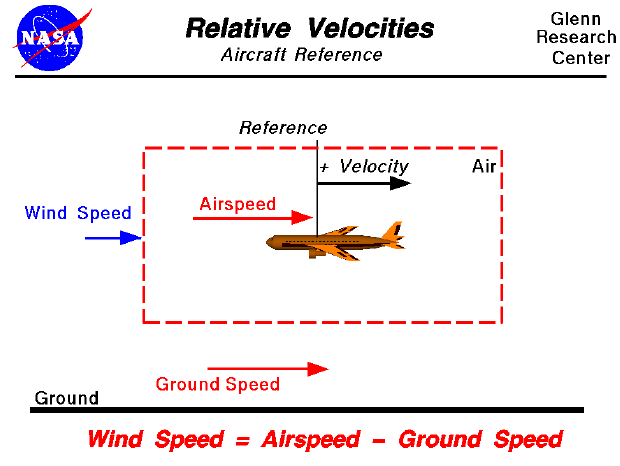

One of the most confusing concepts for young aerodynamicists is the relative velocity between objects. Aerodynamic forces are generated by an object moving through the air. Aerodynamic lift, for instance, depends on the square of the velocity between the object and the air. Things get confusing because not only can the object be moved through the air, but the air itself can move. To properly define the velocity, it is necessary to pick a fixed reference point and measure velocities relative to the fixed point. In this slide, the reference point is fixed to the airplane, but it could just as easily be fixed to the ground.
The important quantity in the generation of lift is the relative velocity between the object and the air. For a reference point picked on the object, the air moves relative to the reference point at the airspeed. The airspeed is a vector quantity and has both a magnitude and a direction. A positive velocity is defined to be toward the tail of the aircraft. The airspeed can be directly measured on the aircraft by use of a pitot tube. From the aircraft, the ground will appear to move aft at some velocity called the ground speed. Again this is a vector quantity.
The air in which the aircraft flys can move in all three directions. In this figure, we are only considering velocities along the aircraft's flight path and we are neglecting cross winds which occur perpendicular to the flight path but parallel to the ground and updrafts and downdrafts which occur perpendicular to the ground. From the aircraft, we can not directly measure the wind speed, but must compute the wind speed from the ground speed and airspeed. Wind speed is the vector difference between the airspeed and the ground speed. On a perfectly still day the wind speed is zero and the airspeed is equal to the ground speed. If the measured airspeed is greater than the observed ground speed, the wind speed is positive.
Suppose we had an airplane which could take off on a windless day at 100 mph (lift off airspeed is 100 mph). Now suppose we had a day in which the wind was blowing 20 mph towards the West. If the airplane takes off going East, it experiences a 20 mph headwind (wind in your face). Since a positive velocity is defined to be toward the tail, a headwind will be a positive wind speed. While the plane is sitting still on the runway, it has a ground speed of 0 and an airspeed of 20 mph (wind speed (20) = airspeed (20) - ground speed (0)). At lift off, the airspeed is 100 mph, the wind speed is 20 mph and the ground speed will be 80 mph (wind speed (20) = airspeed (100) - ground speed (80) ) If the plane took off to the West it would have a 20 mph tail wind (wind at your back). This gives a negative wind speed. At lift off, the airspeed is still 100 mph, the wind speed is -20 mph and the ground speed will now be 120 mph (wind speed (-20) = airspeed (100) - ground speed (120) ). So the aircraft will have to travel faster (and farther) along the ground to achieve lift off conditions with the wind at it's back.
Comparing this example with the ground reference, we
see that the magnitudes of all the velocities are the same, but the sign of
the wind speed has changed with the reference velocity direction.
Navigation..
Go to...
byTom
Benson
Please send suggestions/corrections to: benson@grc.nasa.gov